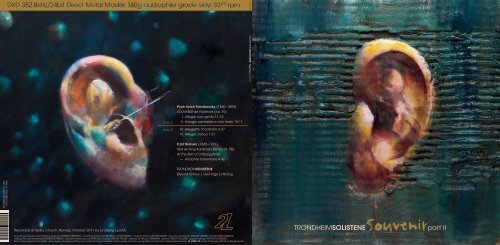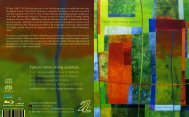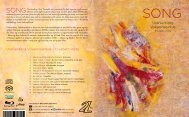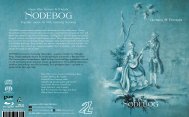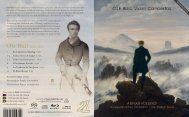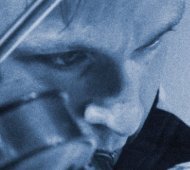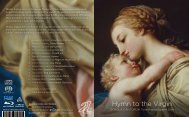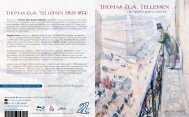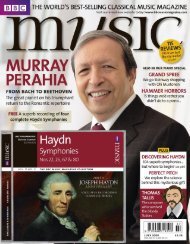TRONDHEIMSOLISTENESouvenirpart II - 2L
TRONDHEIMSOLISTENESouvenirpart II - 2L
TRONDHEIMSOLISTENESouvenirpart II - 2L
You also want an ePaper? Increase the reach of your titles
YUMPU automatically turns print PDFs into web optimized ePapers that Google loves.
EAN-13: 7041888517221<br />
ISRC: NOMPP1212080-120<br />
Recorded at Selbu Church, Norway, October 2011 by Lindberg Lyd AS<br />
Pyotr Ilyich Tchaikovsky (1840–1893)<br />
SOUVENIR de Florence (op. 70)<br />
I. Allegro con spirito 11:12<br />
<strong>II</strong>. Adagio cantabile e con moto 10:11<br />
<strong>II</strong>I. Allegretto moderato 6:27<br />
IV. Allegro vivace 7:31<br />
Carl Nielsen (1865–1931)<br />
Ved en Ung Kunstners Baare (fs. 58)<br />
At the Bier of a Young Artist<br />
— Andante lamentoso 4:42<br />
TRONDHEIMSOLISTENE<br />
Øyvind Gimse / Geir Inge Lotsberg<br />
recording producer and balance engineer MORTEN LINDBERG recording technician BEATRICE JOHANNESSEN musical director ØYVIND GIMSE executive producers STEINAR LARSEN and MORTEN LINDBERG<br />
editing, mix and mastering MORTEN LINDBERG vinyl pre-mastering and DMM disc cutting HENDRIK PAULER pressed by PALLAS GERMANY artwork HÅKON GULLVÅG graphic design MORTEN LINDBERG<br />
Financially supported by NTNU – Norwegian University of Science and Technology, Trondheim Municipality, Fond for lyd og bilde and Fond for Utøvende Kunstnere <strong>2L</strong>-090C-LP made in Norway 20©12 Lindberg Lyd AS<br />
side C<br />
side D<br />
<strong>2L</strong>-090C-LP TRONDHEIMSOLISTENE Souvenir part <strong>II</strong><br />
<strong>TRONDHEIMSOLISTENESouvenirpart</strong> <strong>II</strong>
How do we listen to music? Indeed, how do<br />
we listen to anything? Our use of our hearing<br />
consists primarily of a conscious shutting out<br />
of our minds the things we don’t want to hear.<br />
Because the ear is always open; we can’t shut it the<br />
way we can our eyes – only at night is our hearing turned down<br />
somewhat, but it is never turned completely off. Even with our eyes closed, even in sleep,<br />
our hearing is our sensual lifeline back to the reality that surrounds us. It is our last line<br />
of defence. It nudges us and fetches us back from sleep whether to the whimpering of a<br />
hungry infant, the alarm clock going off or (presumably once in a distant past) to the<br />
hungry growl of a bear heading into the family cave. From the moment of our birth to the<br />
moment of our death, as long as our hearing works, we are surrounded by sound from all<br />
sides. We are afloat in an ocean of sound. We have no choice.<br />
That is why sound can feel so insistent, so almost rude. From the downstairs neighbour’s<br />
incessant fixing-upping to the oaf across the street from whose windows music always<br />
pours on beautiful summer evenings. It isn’t the music that is the problem – the oaf may<br />
have an excellent taste in music; what offends is how the insistent the act is. He gives us<br />
no choice. Or rather, there is the choice between going over, ringing his doorbell and then<br />
killing him, or shutting our own windows. Those are the choices we can live with.<br />
And yet, most of the time living in this lifelong cacophony is fine. Most of the things<br />
we shut out, we relegate to the subliminal parts of our consciousness: the noise of traffic,<br />
swarms of people, footfall on the pavement, the computer fan, the sound of the breeze,<br />
raindrops, the voices of children on the playground down the street, the clatter of cutlery<br />
in the café – it all becomes one big hum, a backdrop which makes for a sort of silence of<br />
the mind. We even experience a feeling of security as we are carried by the stream of the<br />
big and small sounds of our everyday lives. Occasionally, young children from an urban<br />
environment may feel scared the first time they come to the wide open spaces at winter<br />
and hear: nothing. The silence in the mountains can seem terrifying. “The great, white<br />
silence,” Nansen termed it. It is related to eternity, to soundless space, to the absence of<br />
life, to death.<br />
But the mountains are not altogether quiet. The hearing readjusts, recalibrates to new<br />
levels. The whooshing of wind over a snow dune. The squeaking of footsteps in snow.<br />
The creaking of a cabin wall. Dogs barking in the distance. When you then return to town,<br />
the constant whoosh of sounds suddenly feels like nothing so much as noise – until after a<br />
couple of days we no longer hear it: we have got used to it once more.<br />
Some sounds speak to us directly; they carry a meaning, are more than just a sound amid<br />
sounds. The human voice is one such sound, always wanting to impart something; it<br />
engages our minds and hearts, whether it speaks to us directly or is merely a snippet<br />
we pick up in passing down a street: “... and then I said to Gunnar, Gunnar I said, don’t<br />
you realize what she’s getting up to on the side?” And we walk on, pondering whatever<br />
that could be. Even when we are spoken to in a language we don’t understand, our inner<br />
analyst is launched into intense, urgent action: is the conductor trying to tell us that our<br />
ticket isn’t valid? Have we got on the wrong train? Have we gone too far? Should we have<br />
gone yesterday? Doesn’t he like us? What is it he wants from us?<br />
Some sounds want to engage us, and engage us directly. Music is one such sound. Like<br />
the human voice it carries meaning, a manmade content in the form of harmonies<br />
and melodic lines, rhythm, tempo, and volume, all of which becomes the medium for a<br />
much deeper content, one of feeling. Sadness, joy, triumph, solemnity, melancholy, hope,<br />
despair, mirth, drama: music brings us all of this in its web of time, timbre, and pitch.<br />
But, depending on how it is produced, it brings us something else besides: the musician’s<br />
personality, the character of the time and place.<br />
Maybe that is why so many experience a vast, qualitative, difference between music that has<br />
been recorded and music that is being performed now. The recorded music is unchanging.<br />
It doesn’t yield and flex. It doesn’t change according to the situation but constitutes a fixed<br />
matrix, which is always the same. It is also usually characterized by being perfect; any of<br />
Auditory bliss<br />
the little hitches and glitches that will normally<br />
accompany the live performance have<br />
been rubbed out. Music performed live on<br />
the other hand adapts to the situation, physically<br />
– in the form of the acoustics and other<br />
characteristics of the venue – but also in a sort of<br />
meeting of minds as it encounters the audience. These can be many or<br />
they can be few, they can be young or old, interested or indifferent. The musicians invariably<br />
adapt to the atmosphere in that moment, the genius loci – the spirit of the place – as<br />
the ancient Romans would have said. And their expression is unique, it is created then and<br />
there; the situation cannot be reproduced. A different form of dynamic arises between the<br />
performers and the audience when the performance is live.<br />
by Erik Fosnes Hansen<br />
You can feel the difference when a famous Oslo-café no longer allows musicians in the<br />
galleries to entertain the guests, but have replaced them with a CD which whirrs and<br />
becomes part of the backdrop. Even if the volume is lower than when the café’s band is<br />
playing, the sound is more insistent because it is mechanical. It becomes irksome, wearying.<br />
It doesn’t yield and flex, but perseveres; it doesn’t address us directly as individuals but<br />
speaks to a sort of abstract general public. The warmth, the immediacy and the intimacy<br />
is missing: because there’s no one there.<br />
Add to that the difference in sound quality between an instrument and a loudspeaker<br />
– I am thinking particularly of acoustic instruments here. Supposing you don’t have<br />
loudspeakers worth a minor fortune, positioned<br />
at the perfect distance from where<br />
you are sitting, and supposing you also don’t<br />
possess a hifi as expensive as a Mercedes<br />
Benz, there will invariably be a marked – or<br />
at best, a subtle – difference between the<br />
music from an instrument and the music<br />
from a box. To me that difference has always<br />
seemed most comparable to the difference<br />
between the heat from a fireplace and that<br />
from an electric heater. It’s possible that I am<br />
imagining this, but personally I very much<br />
feel life emanating from live music. The<br />
vibrations of the cello string, the silvery<br />
breath of a flute, the sharp division of air<br />
coming from the reed – these are extensions<br />
of the organism; the musician is living his<br />
music; his personality, indeed his very physicality,<br />
down to his gestures and breathing,<br />
emanate through them. That is what makes<br />
them so human; they become almost voicelike.<br />
They fill the room and the people in it.<br />
These qualities are difficult, perhaps even<br />
impossible, to capture in a recording. The recording<br />
is done – provided what is recorded<br />
isn’t a live performance – under controlled, often slightly sterile conditions. The musicians<br />
haven’t dressed up for the occasion; it’s often early in the day, and there’s no audience to<br />
give that buzz, to provide those little coughs, those craned necks and that breathing. And<br />
of course there is also no applause. Instead there is a man in a loudspeaker who says ‘cut’<br />
and ‘whenever you’re ready’. He isn’t even in the same room as them. Every so often the<br />
conductor leaves his ensemble and runs out to him to listen to the latest attempt. If there<br />
is a window in the recording booth (but there isn’t always), you can see them talking,<br />
gesticulating. I remember an old philharmonic musician referring to this silent situation<br />
as “the fish tank” – incidentally he never said which side of the pane he felt he was on.<br />
Recording music does, in other words, present challenges greater than the purely technical<br />
– that is to say, challenges beyond the mere mechanical reproduction which undoubtedly<br />
has become very good in later years. The recording scenario is in itself frequently different<br />
from when you play live to an audience. The listening situation is similarly different. Often<br />
it is reduced from a shared experience to a highly individual affair; perhaps you are just<br />
two or three people listening, but often only: I. I alone. The music carried by the recording<br />
is intended for me. As audience I get a completely different angle on the matrix constituted<br />
by the recording. It requires more from my powers of re-creation and more mindfulness<br />
on my part than does the concert hall experience.<br />
In a way this is not unlike the novel; the novel and the situation in which its reader finds<br />
him or herself. Like the recording, the novel is always an unchanging matrix which the<br />
reader relates to. In reading, art appreciation is a highly individual, hermetic condition,<br />
and the reader must endow each word with a tone, infuse each character with life and give<br />
light to the vistas. The writer must make a very detailed inventory of his artistic effects in<br />
order that his text may work on this micro level, and have the right dimensions, depth and<br />
personality. Intimacy. A voice.<br />
The record producer is faced with the same challenge. The key to all good recordings is to<br />
be found, I think, in realizing the profound difference between a live performance and a<br />
recording, and not trying to bridge that gap. It’s about discovering what only the recording<br />
can do. To do so the producer must become an active participant in the musical process<br />
itself, on a par with the musicians and the conductor. The producer has to discover the<br />
timbre and acoustic pattern, which will bring out the more abstract qualities of the<br />
music – bringing us closer to the innermost intensions of the composer, to the perfect<br />
resonance with the composer’s perfect score.<br />
Music – detached from its immediacy in the<br />
now, in the room, with all its little hitches<br />
and glitches – defined as something finite,<br />
something repeatable.<br />
TrondheimSolistene are not only a leading<br />
and living chamber orchestra, but are also<br />
always looking for new ways to communicate<br />
music through those recordings to<br />
which they devote so much time and prestige.<br />
In order to avoid those frequently static<br />
acoustic patterns which so often characterize<br />
classical recordings (first violinists on<br />
the left, and so forth and so tutti on) and attempt<br />
a rapprochement to the music so that<br />
it doesn’t merely copy the musicians’ places<br />
on the dais, producer Morten Lindberg has<br />
taken some interesting measures on this recording<br />
– measures that became real challenges<br />
for the musicians and which tested the<br />
ways in which they usually perform. Indeed<br />
one might even say that it tested their very<br />
unity of execution. During the recording of<br />
Tchaikovsky’s Serenade for Strings, the musicians<br />
were separated from their usual seating<br />
partners and placed in a circle, in the middle of Selbu Church, all of them at an equal<br />
distance from the microphones which were in the middle of the room (along with the<br />
painter Håkon Gullvåg). Such a method tests the musicians’ abilities both as soloists and<br />
as an ensemble, and it must have felt quite daunting to start with. But as the truly excellent<br />
orchestra they are, TrondheimSolistene soon arrived at a new artistic freedom in this<br />
situation and started to make music.<br />
To the listening ear this makes for a startlingly different experience. The melodic lines<br />
come at you from every side, detached from any fixed sense of direction. And aided by the<br />
acoustics provided by the medieval walls of Selbu Church, the work becomes something<br />
which seems to soar about you, or in which you yourself seem to soar. Perhaps, you think,<br />
this is how Tchaikovsky himself heard it as he wrote it down, detached from the starboard<br />
and port of the dais. But it can also be seen as a new way of recording where the production<br />
itself takes on a more active role in the music. Adding qualities to the recording which<br />
only a recording can possess. It is an excellent solution to the dilemmas which confront<br />
recorded music. Just as the parallel release of a LP-version opens to the unique auditory<br />
depth which the vinyl adds to the listening experience.<br />
There is, interestingly, an early recording of Tchaikovsky’s voice, done by the company<br />
Edison in Moscow in 1890. Several of his musician friends participate on the recording<br />
which lasts just under a minute, and they cheer and sing and make snide remarks, like kids<br />
with a tape recorder; towards the end Tchaikovsky even whistles. What about the sound<br />
quality? Let’s just say that it has come a long way since then. It sounds as if they are talking<br />
into a tin and have sore throats. They even sing off key. They obviously don’t take this<br />
seriously, but make cuckoo-sounds for the fun of it. These few, jarring seconds of recorded,<br />
preserved sound paradoxically become a memento of a time when recordings were still<br />
not really in existence, a time when music was always a deliberate act. A time of greater<br />
silence and a different sort of sound. Presumably there was also a different relationship<br />
between the expectations of the artist’s technical virtuosity and the expectations of his<br />
personality – allowing his personality to make up for more than it could today. The<br />
dizzying progress of the recording technique in the past hundred years has without a doubt<br />
raised our expectations of technical proficiency on the part of the musician: a bum note, or<br />
a note just slightly off, is forever captured on a recording as if set in stone.<br />
An ear graces the covers of this recording. It is an amalgamation of Tchaikovsky’s and Carl<br />
Nielsen’s ears, based on pictures from their youths, painted by Håkon Gullvåg – presumably<br />
after he had stood for so long and listened to TrondheimSolistene in the church that he felt<br />
like one great, big ear himself. The ear is very much an illustration of the rapprochement<br />
on this production. For the last ten years artistic director Øyvind Gimse has put his<br />
distinctive mark on TrondheimSolistene, and you sense his musical ideals in both their<br />
live performances and recordings such as this. Along with Geir Inge Lotsberg and<br />
producer Morten Lindberg, Gimse and the orchestra have chartered new auditory<br />
landscapes with this recording. In a sense the recording can be said to come across as<br />
disembodied and distilled down to a pure listening experience, a pure ear experience.<br />
As Gullvåg’s illustration suggests, what we as listeners encounter here is sheer auditory<br />
bliss. TrondheimSolistene take a new step towards bridging the gap between themselves<br />
and their audience. It is not the gap between the live performance and the recording which<br />
they attempt to close. It is the gap between the recording and the living, ever open human<br />
ear.<br />
TRONDHEIMSOLISTENE<br />
violin<br />
Geir Inge Lotsberg<br />
Daniel Turcina<br />
Anja Aubert Bang<br />
Stina Elisabet Andersson<br />
Anders Larsen<br />
Anna Adolfsson Vestad<br />
Cathrine Egeriis Søndberg<br />
Hilde Kolstad Huse (part I)<br />
Åse Våg Aaknes (part I)<br />
Tora Stølan Ness (part I)<br />
Karl Jonatan Lilja (part I)<br />
Ingrid Wisur (part I)<br />
Fride Bakken Johansen (part <strong>II</strong>)<br />
Sigmund Tvete Vik (part <strong>II</strong>)<br />
Erling Skaufel (part <strong>II</strong>)<br />
viola<br />
Frøydis Tøsse<br />
Verona Rapp<br />
Anne Våg Aaknes (part I)<br />
Kristoffer Bjerke Gjærde (part I)<br />
Ole Wuttudal (part <strong>II</strong>)<br />
Bergmund Wahl Skaslien (part <strong>II</strong>)<br />
Lena Louise Lindquist (part <strong>II</strong>)<br />
translated from Norwegian by Mette Petersen<br />
cello<br />
Øyvind Gimse<br />
Tabita Berglund<br />
Katrine Pedersen (part I)<br />
Cecilie Koch (part <strong>II</strong>)<br />
Jaroslav Havel (part <strong>II</strong>)<br />
bass<br />
Erik Løwendahl (part I)<br />
Rolf Hoff Baltzersen (part <strong>II</strong>)


